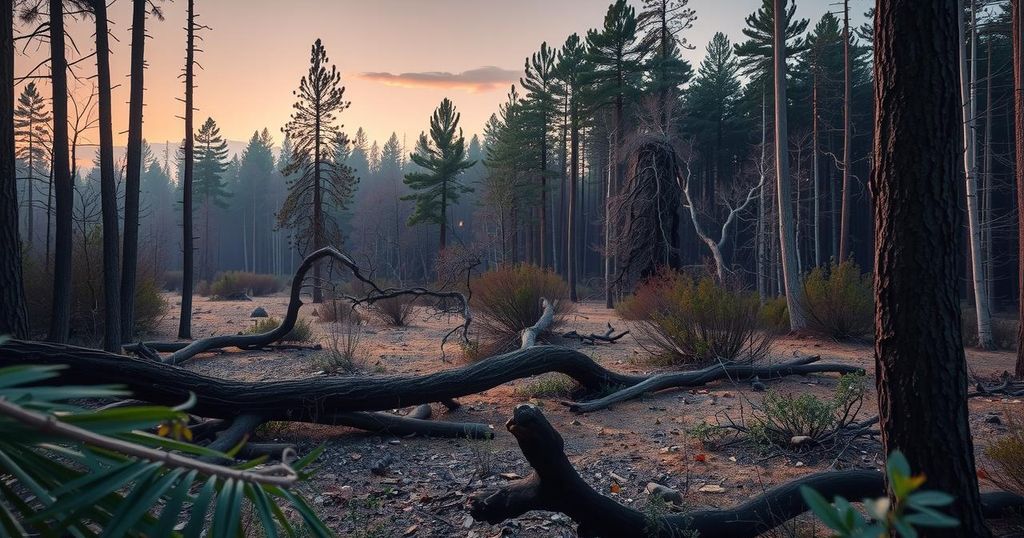World news
” STEINBERG, AFRICA, CLIMATE, CLIMATE CHANGE, ENVIRONMENT, EXTREME WEATHER, HELENE, MICHELE STEINBERG, MID - ATLANTIC, NATIONAL FIRE PROTECTION ASSOCIATION, NATURAL DISASTERS, NEW ENGLAND, NORTHEAST TENNESSEE, SAFETY, SOUTH AFRICA, SOUTHWEST VIRGINIA, STEINBERG, VIRGINIA
Daniel O'Connor
0 Comments
Hurricane Helene’s Long-Term Impact on Wildfire Risk and Upcoming Hurricane Season
Hurricane Helene’s devastation in parts of the Southeast may elevate wildfire risks due to the resulting debris. The National Fire Protection Association discusses the dual role of wildfires in ecosystems and the risks they pose when homes become fuel. A forecast indicates an above-average 2025 hurricane season, emphasizing the need for readiness in fire-affected areas.
Last fall, Hurricane Helene inflicted significant damage across Southwest Virginia, Northeast Tennessee, and Western North Carolina. These communities continue to recover months after the storm, which may lead to further natural disasters typical for the season. Michele Steinberg, Wildfire Division Director at the National Fire Protection Association, noted that the debris from Helene is likely increasing wildfire risks in the region.
Steinberg emphasized that while wildfires can be detrimental, they also play a beneficial role in ecosystems by restoring nutrients to the soil and facilitating the growth of certain plant species. Wildfire seasons in the Northeast and the Southern states predominantly occur in spring and fall, coinciding with dry weather conditions.
She delineated how trees, grasses, and shrubs serve as fuel for wildfires. When homes and vehicles become the fuel source, the risks escalate significantly. Tropical systems like Hurricane Helene further exacerbate this issue by leaving behind substantial debris, which consists of dead plant material, creating an elevated threat for wildfires.
“Increased fuel from post-hurricane conditions leads to more intense wildfires,” Steinberg explained. Moreover, following a hurricane, emergency responders prioritize restoring infrastructure over managing wildfire risks, complicating the situation.
Steinberg urged residents to stay informed about wildfire risks, particularly during Red Flag Warnings, when conditions become conducive to rapid fire spread due to dry, hot, and windy weather. Homeowners can take preventive measures by clearing debris and material from their properties to reduce vulnerability to wildfires.
The National Fire Protection Association offers numerous resources for wildfire preparedness. Several Virginia communities are involved in the NFPA’s Firewise USA program, emphasizing collaborative efforts to protect homes and public spaces. Virginia’s spring wildfire season extends until the end of April.
Additionally, a recent prediction by Colorado State University anticipates an above-average hurricane season in 2025, forecasting 17 named storms, including nine hurricanes and four major hurricanes. Levi Silvers noted that a combination of warm sea-surface temperatures and a weak La Nina event contributes to this projection.
The Atlantic hurricane season spans from June 1st to November 30th, calling for vigilance in fire-prone areas during this period. For ongoing updates, residents can sign up for the CommonWx newsletter from Radio IQ.
In summary, Hurricane Helene’s aftermath poses a heightened risk for wildfires in affected regions due to increased fuel from downed vegetation. Residents are encouraged to remain vigilant and take preventative measures against wildfires during favorable conditions. Furthermore, projections for an above-average 2025 hurricane season underscore the importance of preparedness for both hurricanes and wildfires alike.
Original Source: www.wvtf.org




Post Comment